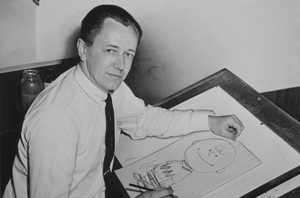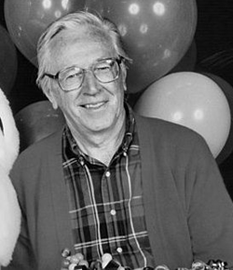|
Charles Schulz
Answer
to Name
This Famous Person Game - March 2015
by Mike McLeod
|
 |
|
|
Charles Monroe Schulz was born on Nov. 26, 1922 in Minneapolis, Minn. Coincidentally, his father Carl was a barber, just like Charlie Brown’s father. Carl was born in Germany, which must have given his son pause when he served as a squad leader for a .50 caliber machinegun team in Europe during WWII. It is reported Charles missed his one opportunity to fire that .50 cal. at the enemy because he had forgotten to load it. Even so, the German soldier in his sights surrendered.
 In his younger years, Charles Schulz learned cartooning through a correspondence course. While working at another job and cartooning on his own time, his comic “L’il Folks,” was accepted for syndication. However, the name was changed by the syndicator because it was similar to another comic strip at the time. The syndicator chose the title of “Peanuts” after Howdy Doody’s Peanut Gallery. Schulz hated the name then and for the rest of his life. In his younger years, Charles Schulz learned cartooning through a correspondence course. While working at another job and cartooning on his own time, his comic “L’il Folks,” was accepted for syndication. However, the name was changed by the syndicator because it was similar to another comic strip at the time. The syndicator chose the title of “Peanuts” after Howdy Doody’s Peanut Gallery. Schulz hated the name then and for the rest of his life.
Charles Schulz’s cartoons were never written for children. He entertained adults by having children say things that adults would say, often from his own experiences in life.
“Nothing takes the taste out of peanut butter quite like unrequited love.”
So said Schulz via Charlie Brown about both of their Little Red-Haired Girls. As a young man, Schultz proposed marriage to Donna Mae Johnson, his Little Red-Haired Girl in real life, and was turned down. In 1951, he married Joyce Halverson.
Schulz may have suffered from depression to some degree, which could be why he often used “depressing humor” in Peanuts—usually at the expense of Charlie Brown. The first Peanuts cartoon published in syndication on Oct. 2, 1950 showed Charlie Brown walking toward two children sitting by a sidewalk.
Little boy (who does all the talking) to the little girl beside him: Well! Here comes ol’ Charlie Brown!
2nd frame (with Charlie Brown walking by): Good ol’ Charlie Brown….Yes, sir!
3rd frame (Charlie Brown has passed by): Good ol’ Charlie Brown…
4th frame: How I hate him!
A surprising way to begin a new comic strip with child characters, but Schulz’s thought (expressed later) was this: “You can’t create humor out of happiness. I’m astonished at the number of people who write to me saying, ‘Why can’t you create happy stories for us? Why does Charlie Brown always have to lose? Why can’t you let him kick the football?’ Well, there is nothing funny about the person who gets to kick the football.” 1
Yet, after Schultz stopped creating his comic strip due to colon cancer when he was in his seventies and just before he died, he experienced remorse about not allowing Charlie Brown a little happiness: “All of a sudden I thought, ‘You know, that poor, poor kid, he never even got to kick the football. What a dirty trick—he never had a chance to kick the football!’”2
By the way, Lucy did hold the ball still once and allow Charlie Brown a chance to kick it, but Schulz had his foot miss the ball completely. That was the way it had to be, as Schulz thought then: “To be consistent, however, we have to let her [Lucy] triumph, for all the loves in the strip are unrequited; all the baseball games are lost; all the test scores are D-minuses; the Great Pumpkin never comes; and the football is always pulled away.”3
All the Peanuts characters were expressions of Charles Schulz thoughts and persona. But Charlie Brown was the “Charlie Browniest,” as Schulz had Lucy and other characters say. Charlie Brown was perhaps the Charles Schulziest, too—happy at times, but often consumed with worry and self-doubt.
“That’s the secret to life…replace one worry with another.”
“I have a new philosophy. I’m only going to dread one day at a time.”
“Sometimes I lie awake at night, and I ask, 'Where have I gone wrong?' Then a voice says to me, 'This is going to take more than one night.”
It probably isn’t fair to string these comments together without knowing the context behind each of them. Perhaps this one balances out Schulz’s perspective:
“My life has no purpose, no direction, no aim, no meaning, and yet I’m happy. I can’t figure it out. What am I doing right?”
 One would think that having a comic strip in more than 2,000 newspapers worldwide, earning Emmy and Peabody Awards for the Charlie Brown TV specials, and being heralded as the creator of one of the greatest comics of all time would generate much happiness, and it probably did. But creative people almost always seem to have doubts. One would think that having a comic strip in more than 2,000 newspapers worldwide, earning Emmy and Peabody Awards for the Charlie Brown TV specials, and being heralded as the creator of one of the greatest comics of all time would generate much happiness, and it probably did. But creative people almost always seem to have doubts.
The income from all of this was stupendous. Peanuts and its spinoff products (20,000 by 1999), books, TV specials, movies, advertising featuring the characters, and so on made Schulz, his wife Joyce and their five children (one adopted from Joyce’s first marriage) extremely wealthy. In 1989, Schulz earned $32 million and a spot on the top ten list of wealthiest entertainers.4 In 2005, five years after his death, his creations earned $35 million.5
Schulz’s huge animation business dominated his time. For more than half a century, he drew all of his strips and did all the lettering for the dialogue in them. Many famous cartoonists employed others to draw, letter and even create their comic strips. Schulz had a small staff to help with correspondence and the marketing and financial side of his business, but he did most of the rest of the work.
His family, however, suffered from the demands on his time and his devotion to Charlie Brown, Lucy and Linus. He and Joyce did not get along, and sad to say, Schulz had an affair with a younger woman. Joyce and he divorced, and Schulz later married Jean Forsyth Clyde (not “the other woman”). Jean and he remained together until his passing in 2000.
Charles Schulz often gave back to the community and honored veterans. He and Joyce purchased an ice skating rink and operated it at a loss so families would have a place to skate. He organized youth and senior hockey tournaments and activities. He regularly remembered Veterans’ Day in his comic strip and believed this: “I think any sensible person with a grasp of history would have to admit that D-Day was the most important day of our century. Without D-Day it’s possible that Europe could have remained for another 25 or 50 years in darkness. I’m glad I wasn’t there, and yet my admiration for the people who were knows no bounds.”6
The simple bronze plaque on his grave lists only this accomplishment: “SGT. US Army World War II.” But facing his grave is a stone bench that features the images of these characters and these words from his last comic strip: “Charlie Brown, Snoopy, Linus, Lucy…How can I forget them…”
Charles Schulz died on Feb. 12, 2000. Perhaps his own words are his epitaph: “All his life he tried to be a good person. Many times, however, he failed. For after all, he was only human. He wasn't a dog.”
Snoopy is another story for another day.
Readers correctly identifying Charles Schulz were: Freda Blair of Montgomery, Ala.; Julie Wilson and Jeanne Boteler, Information Specialists at the Georgia Visitor Information Center in Lavonia, Ga.; Scott and Carolyn Brown of Montgomery, Ala.; Florence Anne Berna, Visitor Center Manager of the Roswell Convention and Visitors Bureau, Roswell, Ga.; and Ted Carlton of Utah.
---------------------------------------
1
Charles Schulz, Charlie Brown, Snoopy and Me, 1981.
2 Home.bt.com, “February 13, 2000: The last Peanuts comic strip appears in print,” by Chas Early.
3 Thomas Inge, editor, Charles M. Schulz Conversations, p. 142.
4 NY Times, “On This Day: February 14, 2000,” “Obituary Charles M. Schulz, 'Peanuts' Creator, Dies at 77,” by Sarah Boxer.
5 Forbes.com, “Top-Earning Dead Celebrities,” by Leah Hoffman, 10/27/2005.
6 Charles Schulz, 1999, https://schulzmuseum.org/timeline/july-1945.
All uncredited quotes are courtesy of Goodreads.com.
Text from the Peanuts comic strip is courtesy of www.gocomic.com/peanuts.
Learn
about more Famous People
|